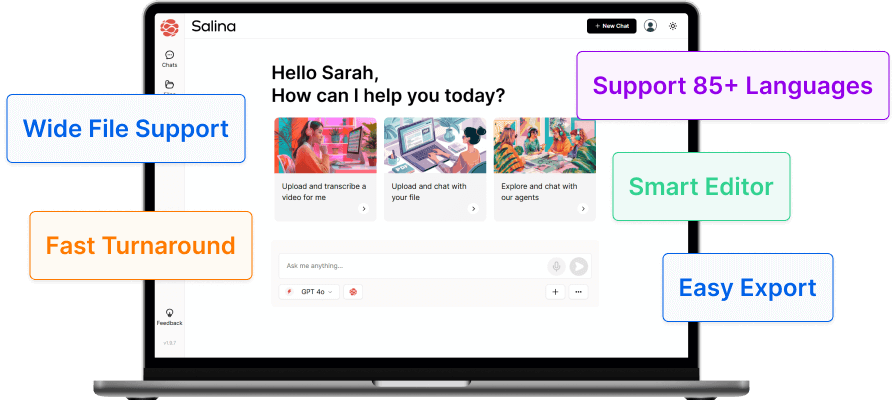Find out what makes audio transcription software a must-have for professionals in every field. Get tips on how to choose the best audio transcription software that fits your needs and boosts your workflow efficiency.
There are times when having the right tool makes all the difference. That’s what I realized one weekend as I set out to paint my room – a project I’d been meaning to do for a while. As I looked through my art supplies, I spotted a framed print of my favorite artist, Frank Ocean. Feeling inspired, I decided to recreate his vibrant style on the bare walls of my room.
I gathered my paints, ready to get started. But when I dipped my brush into the first color, I ran into a problem. The bristles were too thick, making it hard to get the delicate brushstrokes I wanted. I didn’t let that stop me though. I searched through my paintbrushes until I found the perfect one – a thin, precise brush that let me capture all the little details. With the right tool in hand, the painting process was a breeze, and I was able to bring Frank Ocean’s art to life on my walls. That showed me how important it is to have the right equipment, whether you’re creating something or taking on a tough work project.
In this guide, we’ll look at what to consider when choosing the best audio transcription software for your needs, just like how I had to pick the perfect paintbrush for what and how I wanted to paint.
What are the Factors to Consider When Choosing an Audio Transcription Software?
Before committing to any audio transcription software, it’s essential to evaluate various factors. The significance of each will depend on your specific use case, budget, and technical expertise. The main aspects you should examine include:
Purpose and Requirements
Identifying your core use case and the specific demands it places on the software will help narrow down your options.
Transcription Process
Consider the workflow and how the software integrates with your existing systems, from audio upload to the final transcript download or display.
Accuracy and Quality
The most critical attribute of any transcription tool is its ability to deliver error-free and contextually accurate transcripts.
Features and Functionality
Beyond just transcribing speech, what additional features can enhance your workflow or improve the final outcome?
Ease of Use
Even the most powerful tool is useless if it’s too challenging to operate effectively. User-friendliness is a vital consideration.
Cost and Budget
The software’s price point, subscription models, and any hidden costs should align with your financial plan.
To get some real-world insights on the best transcription options, I turned to a recent Reddit thread in the r/podcasting community. The discussion provided helpful recommendations and perspectives on various transcription services and programs
This Reddit thread offers a practical overview of top transcription solutions, highlighting the tradeoffs between them. It’s a useful resource for podcasters and others in need of reliable and efficient transcription tools.
Now, let’s further break down each of these factors and guide you through making the right selection.
1. Purpose and Requirements
Understanding why you need audio transcription software is crucial to finding the perfect fit. Whether it’s for SEO optimization of podcasts, creating meeting minutes, or media subtitling, your purpose will dictate your software essentials. Is it for one-off use or part of a daily workflow? Are you transcribing one speaker or multiple participants?
Core Functionality
Look for features such as speaker recognition, punctuation control, and the ability to handle multiple audio file formats. In addition, does the software support your industry-specific language and jargon? Remember, not all transcription software is created equal, and you’ll want a tool that can understand, interpret, and transcribe with precision.
Use Case Scenarios
Dive into a few use cases to fully understand what the process will look like with each software. How does it manage accents and background noise? Can it transcribe in real-time for live events? Examine its versatility regarding different speaking styles and volumes, as this can vary considerably depending on your use case.
Take a look at this LinkedIn post by Reverie Language Technologies for a clear look at how audio transcription can benefit you. It’s packed with examples and aims to give you the clarity and confidence you need to decide if it’s right for your specific needs.
Legal and Security Considerations
In certain industries, where confidentiality and legal adherence are paramount, it’s critical to choose a solution that prioritizes security. This means looking into software that offers end-to-end encryption and is compliant with your industry’s data protection regulations.
2. Transcription Process
The utility of an audio transcription tool often hinges on its integration within your workflow. How seamlessly it manages the transcription process can make a significant impact on your productivity.
Audio File Compatibility
Some tools may only support certain audio file formats or require you to convert files before transcription, which can be a time-consuming step. Ensure the software is compatible with your preferred audio input method, whether that’s recording in-app, uploading files, or using third-party recording services.
Integration with Other Tools
For an optimal workflow, your transcription software should integrate with your current tech stack. This may include compatibility with video editing software, online storage platforms, or customer relationship management (CRM) systems, streamlining the overall process and ensuring that transcribed content is readily accessible in your key applications.
Turnaround Time
Some transcription software can deliver verbatim transcripts in near real-time, while others may take minutes, hours, or even days. Understand the expected turnaround time and how it fits with your scheduling needs, especially if you handle time-sensitive material such as news updates or legal proceedings.
3. Accuracy and Quality
Nothing is more important than the accuracy and quality of the transcripts. This is the primary reason for employing transcription software, so you must prioritize this factor.
Voice Recognition Technology
The software’s underlying technology will significantly impact transcript quality. Look for tools that leverage the latest in machine learning and neural network models, which have been trained on vast datasets to understand natural language nuances and voice inflections.
Review and Editing Tools
Even the best AI can make mistakes, so it’s essential to have robust editing features. Can the software easily identify and correct misinterpretations, and how does it handle non-standard entries or new terms? A tool that provides a clear interface for straightforward corrections and feedback mechanisms to improve future transcriptions is invaluable.
Quality Control
Consider if the software offers any quality control measures, such as a layered editing process, where multiple people can review and approve transcripts. If your content is particularly sensitive or high-stakes, having a human proofreader coupled with tech-assisted transcription might be the best approach.
4. Features and Functionality
The bells and whistles of your potential transcription software can turn a good tool into a great one. Consider which of these extras will genuinely benefit your operations and which could be distracting or unnecessary.
Advanced Punctuation
For content that requires a high level of polish, tools with advanced punctuation options can save a significant amount of editing time. If you need to indicate emotions or use the transcripts as scripts, features like speaker labels, timestamps, and customizable punctuation are indispensable.
Verbatim vs. Clean Transcripts
Some software can produce highly edited, clean copies of your transcripts, while others will provide verbatim text with all the filler words and pauses. Think about which style will suit your content and whether the tool offers customizable settings to switch between the two.
Analytics and Insights
For data-driven content marketing strategies, transcription tools that provide insights into keywords, sentiment analysis, and engagement metrics can be a goldmine. These features enable you to refine your approach based on audience trends and reception, turning your transcripts into actionable data.
5. Ease of Use
The user experience is a critical factor that often gets overlooked. A tool that is intuitive to use will save time and reduce frustration, which are both invaluable resources in a busy content creator’s day.
Training and Support
Look for companies that offer thorough documentation, training resources, and responsive customer support. The learning curve for new software can be steep, but ongoing guidance can help maximize efficiency quickly. Consider whether the provider offers onboarding assistance or tutorials to help you get the most out of your investment.
Customization and Personalization
Your ideal transcription tool should cater to your specific needs. This means the ability to create custom dictionaries, modify language models, or even tailor the AI to recognize unique industry jargon. The more the software can be personalized, the better it will adapt to your voice and style over time.
User Community and Feedback Loops
Communities of users can be excellent sources of knowledge, tips, and even workarounds for common issues. Does the software provider have an active user community or a feedback mechanism for users to share their experiences and suggest improvements?
6. Cost and Budget
The cost of transcription software can vary significantly, from free to hefty subscriptions or pay-per-use models. Understanding your budget and what each tool offers at various price points is primarily important to make a cost-effective choice.
Subscription Model
Most modern software services operate on a subscription basis, which can be monthly, yearly, or even based on usage. This can lead to a more predictable cost, but be sure to calculate the total amount over time. Does the subscription include upgrades and new features, or do these come at an additional cost?
Hidden Costs
Be wary of any hidden fees or usage overages that could inflate the price. Some providers charge for extra features, additional storage, or a higher number of minutes transcribed. Make sure to read the fine print and understand the full pricing structure before committing.
Return on Investment
Consider the long-term benefits and time savings that the software will offer. While a higher upfront cost might be intimidating, the return on investment from increased content output, higher quality, and reduced labor hours can make it worthwhile.
Key Takeaways
- Stay flexible and open to new tools not initially considered.
- Take advantage of demos and free trials to test software in real-life scenarios.
- Seek testimonials and reviews from users with similar needs and challenges.
- Balance practical analysis with the willingness to explore different solutions.
- Align your priorities, such as speed, privacy, or integration, with potential software options.
What’s Next
Armed with this guide, you are now empowered to make a confident and informed decision when selecting audio transcription software. Invest the time to research, test, and compare different solutions. Remember that the right software can not only save you time and effort but also unlock new possibilities for your content creation and management. Now, go forth and transform your approach to audio transcription with the tool that suits your needs best.
Transcription software has revolutionized the way content creators and podcasters process and disseminate information. Whether taking notes for academic research, improving accessibility, creating subtitles for videos, or legally documenting conversations, audio transcription tools are an indispensable part of modern workflows. With the market flooded with various voice-to-text solutions, how do you select the best one for your unique needs?
To assist you in this crucial decision-making, we’ve crafted a comprehensive guide to choosing audio transcription software. By the time you finish reading this post, you’ll be equipped with the knowledge to make an informed choice, leading to more efficiency in your work and ultimately saving you time and resources.





